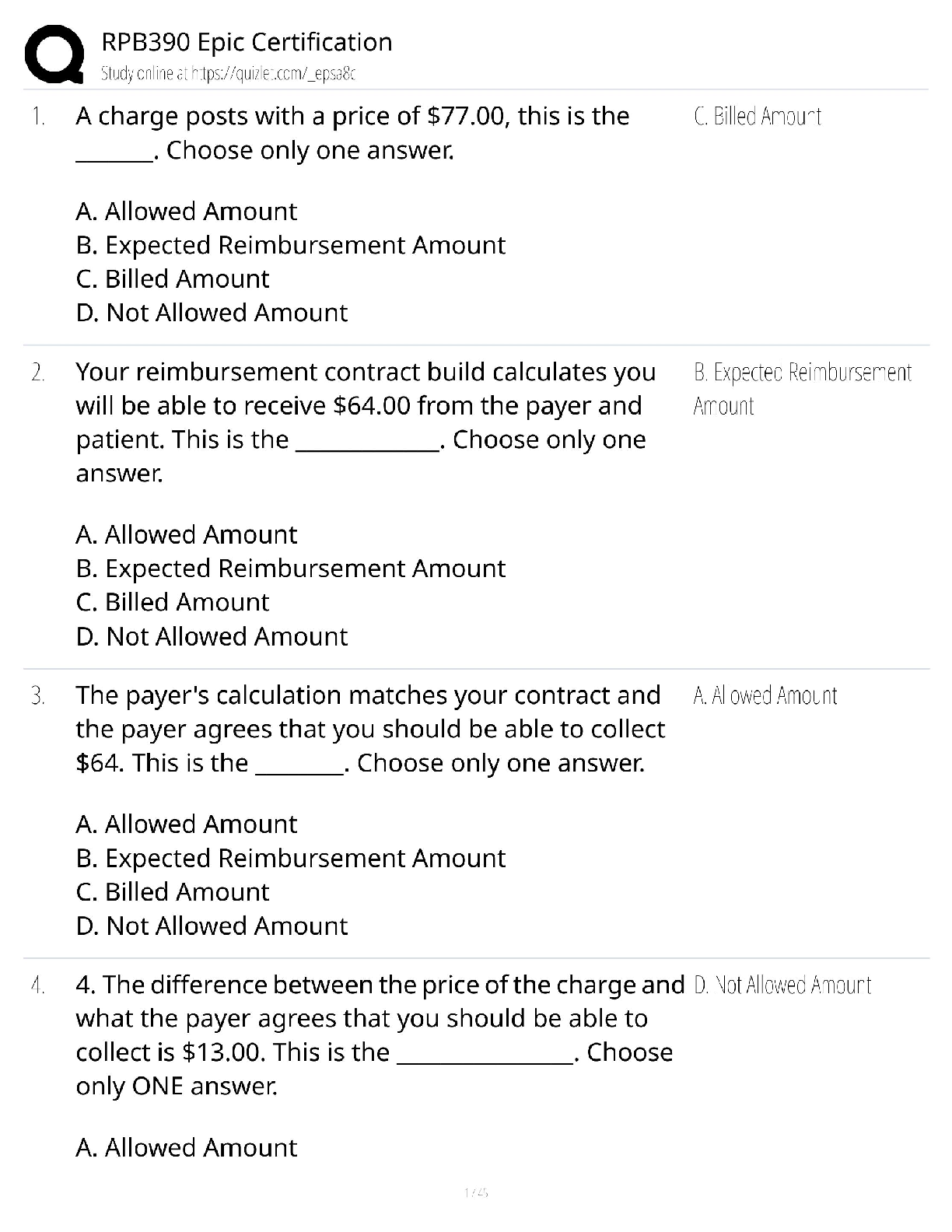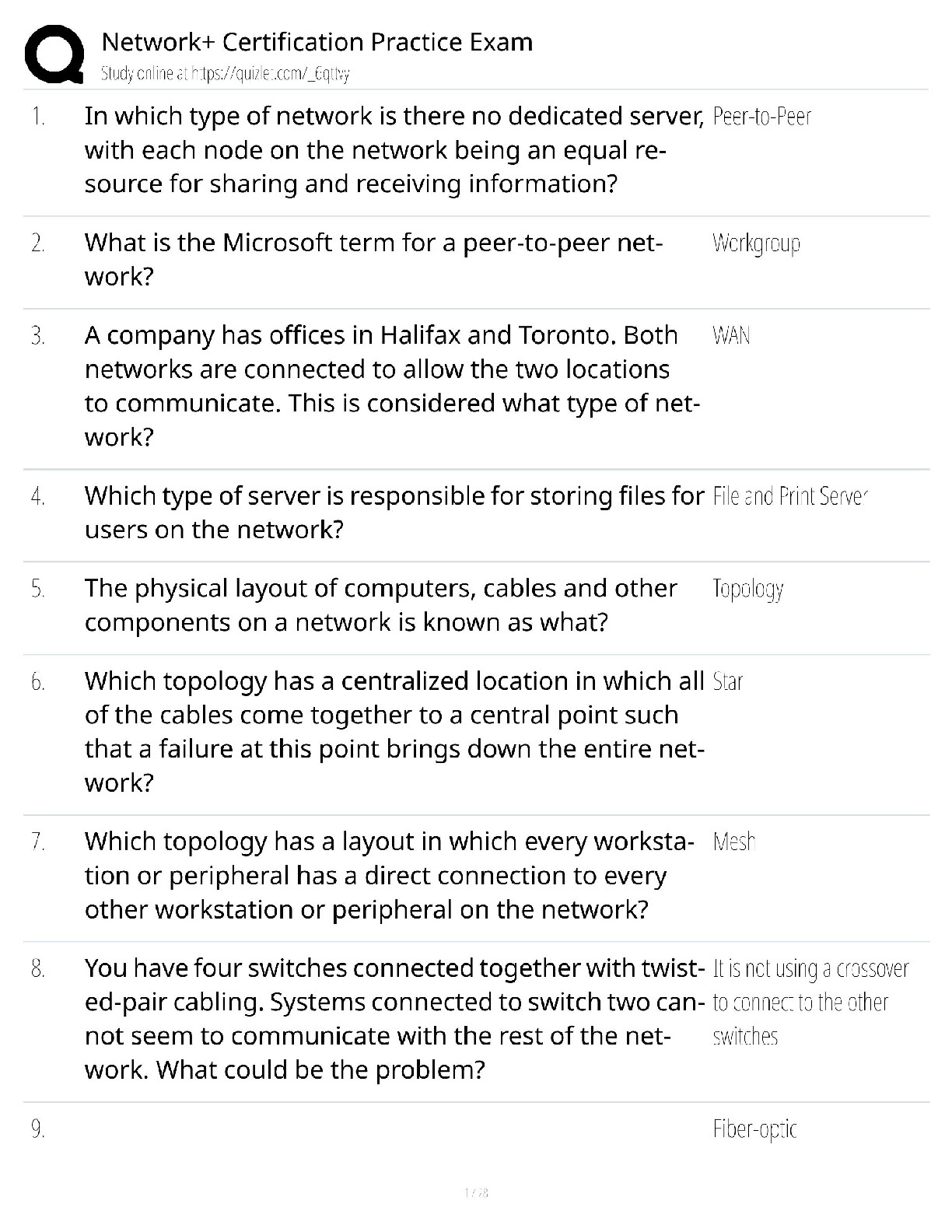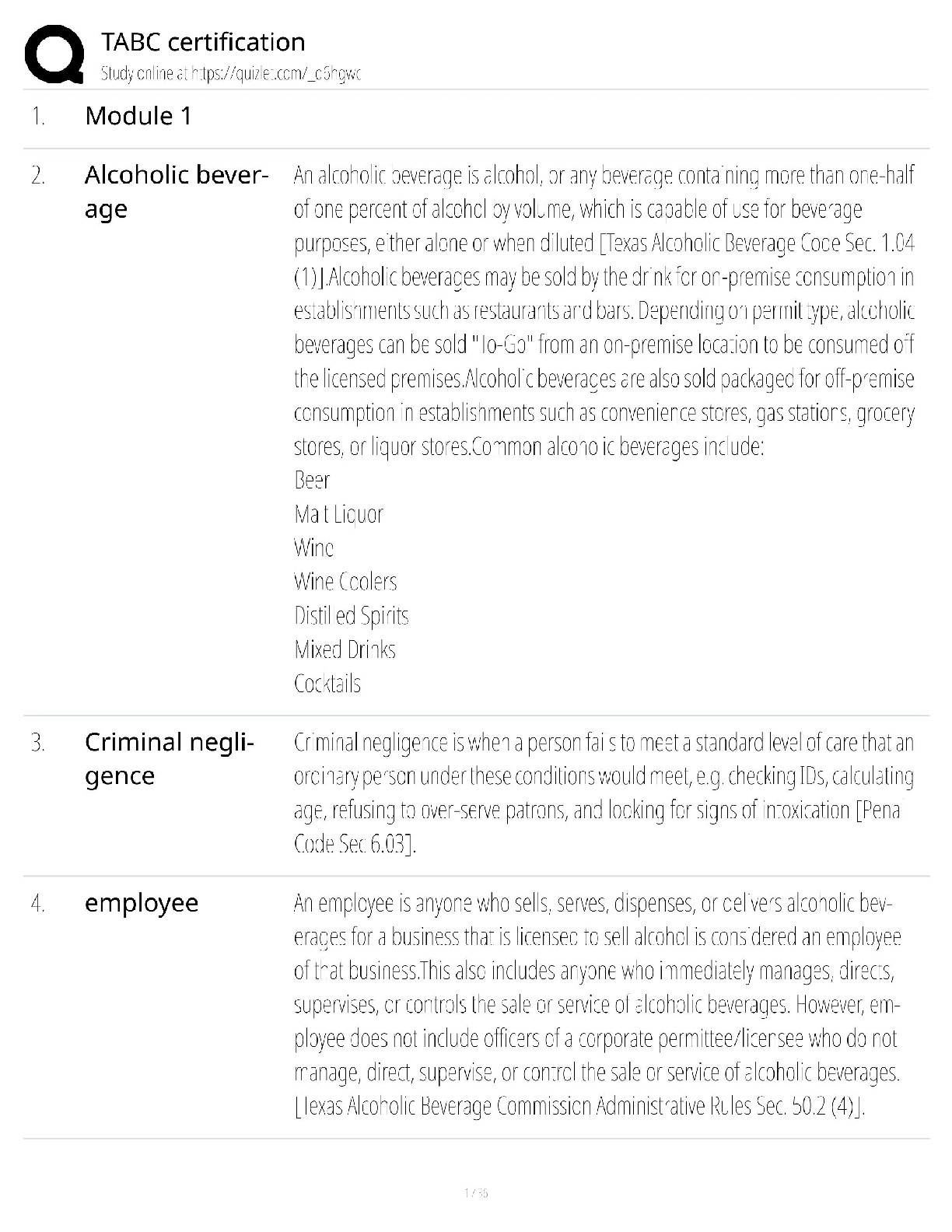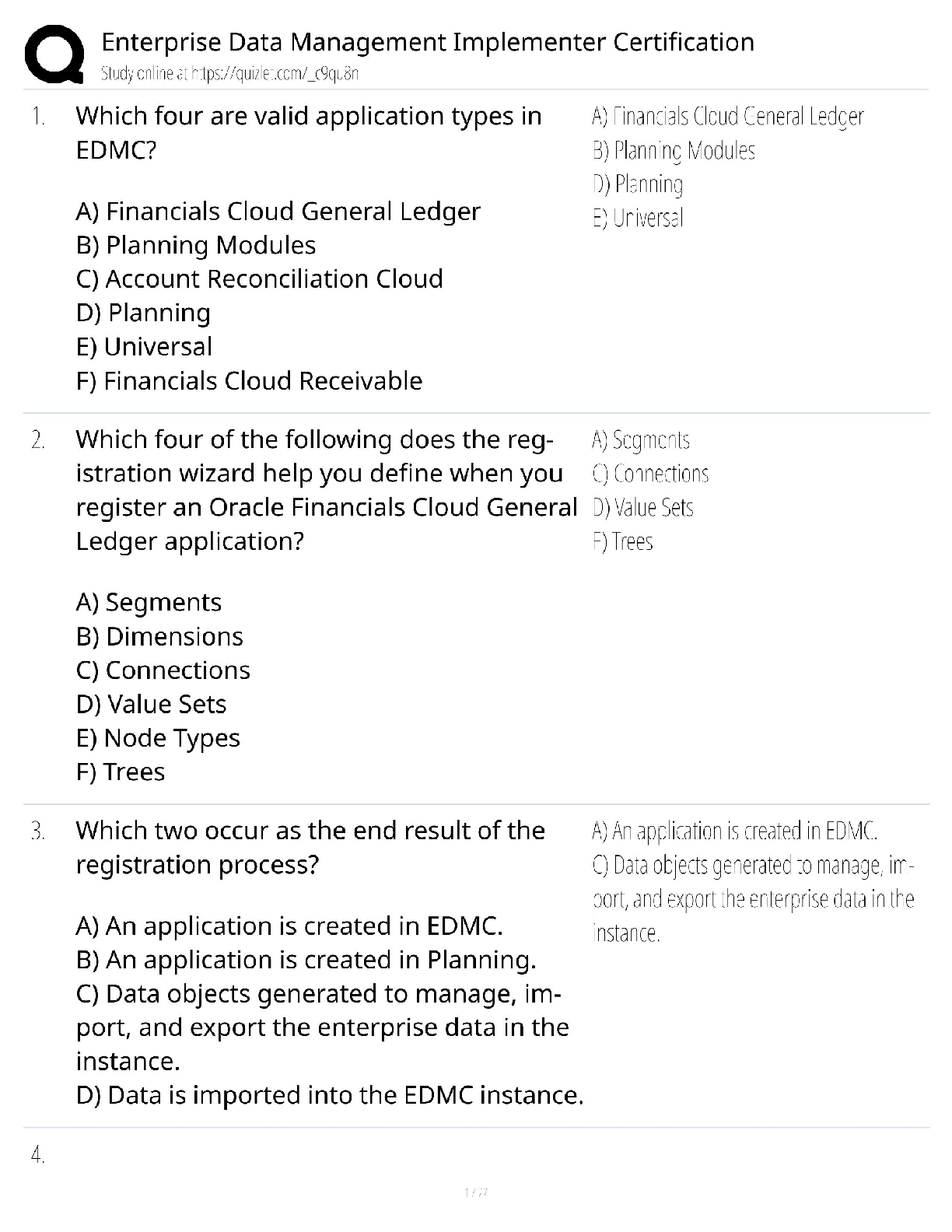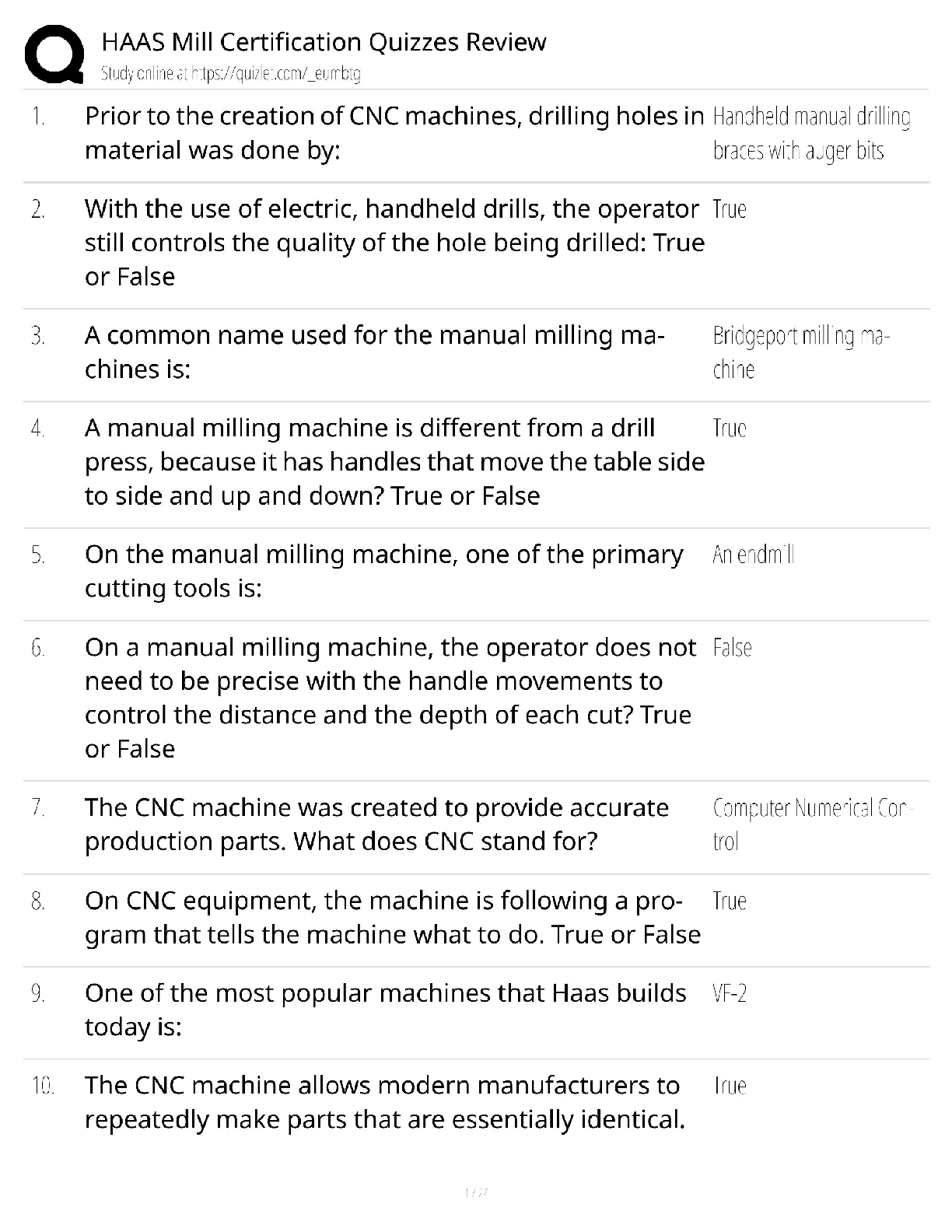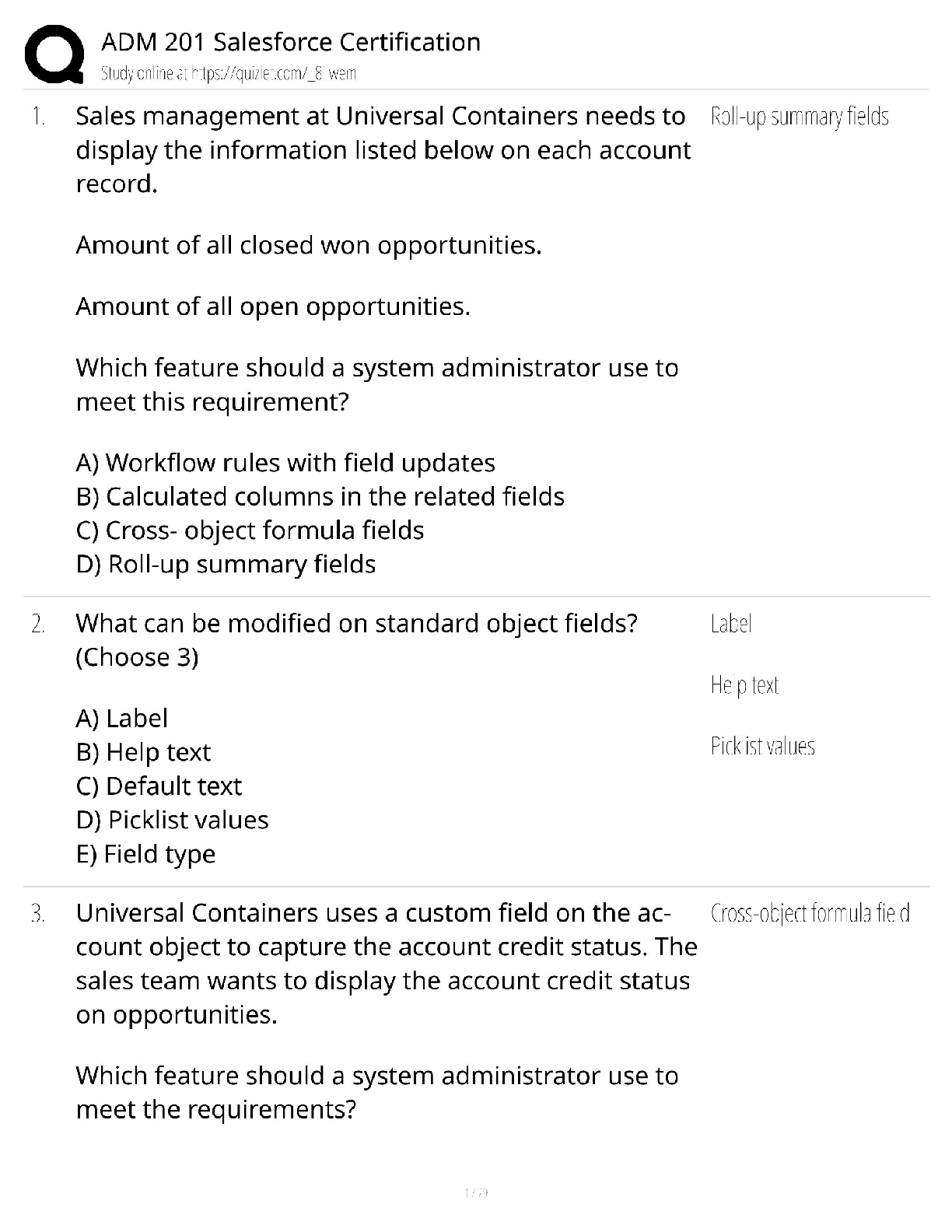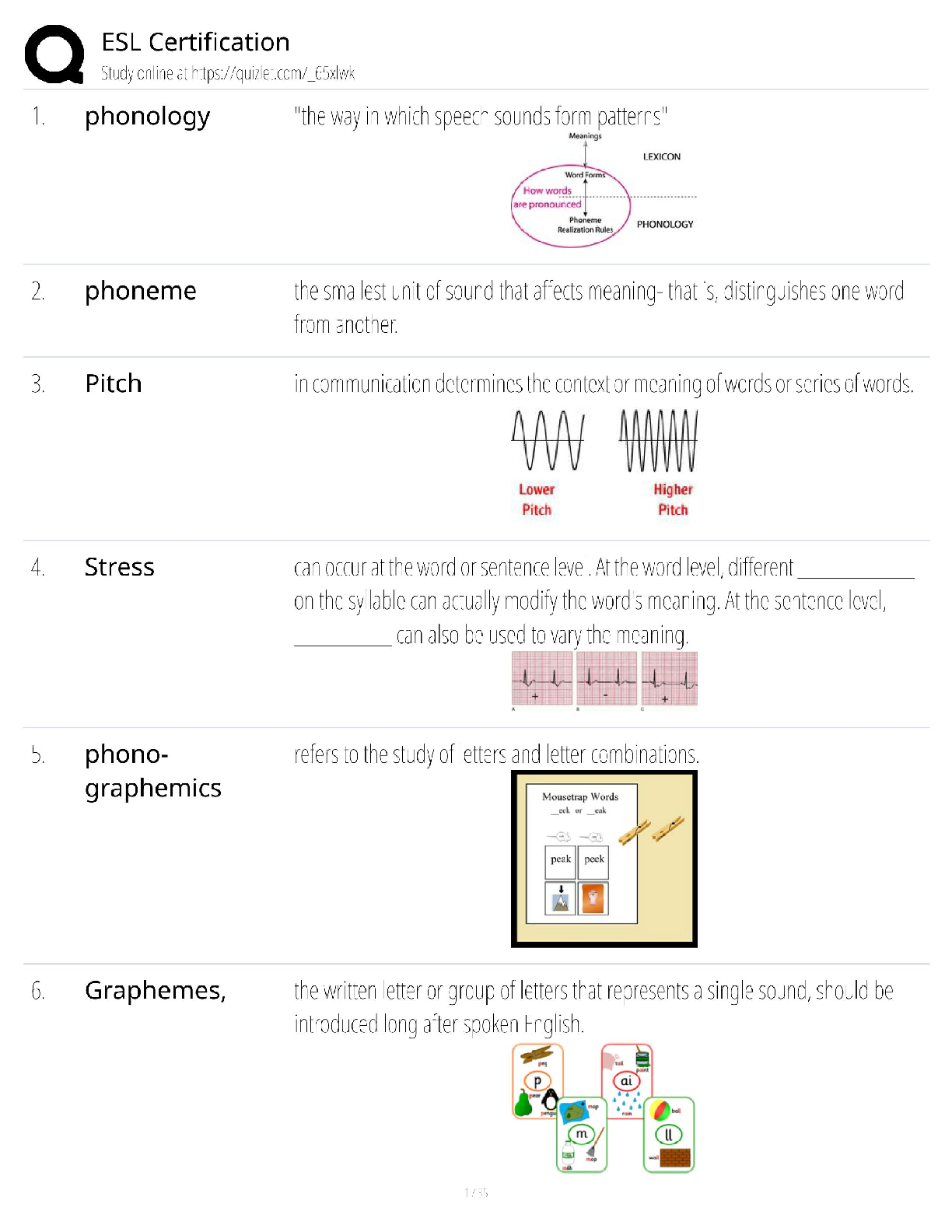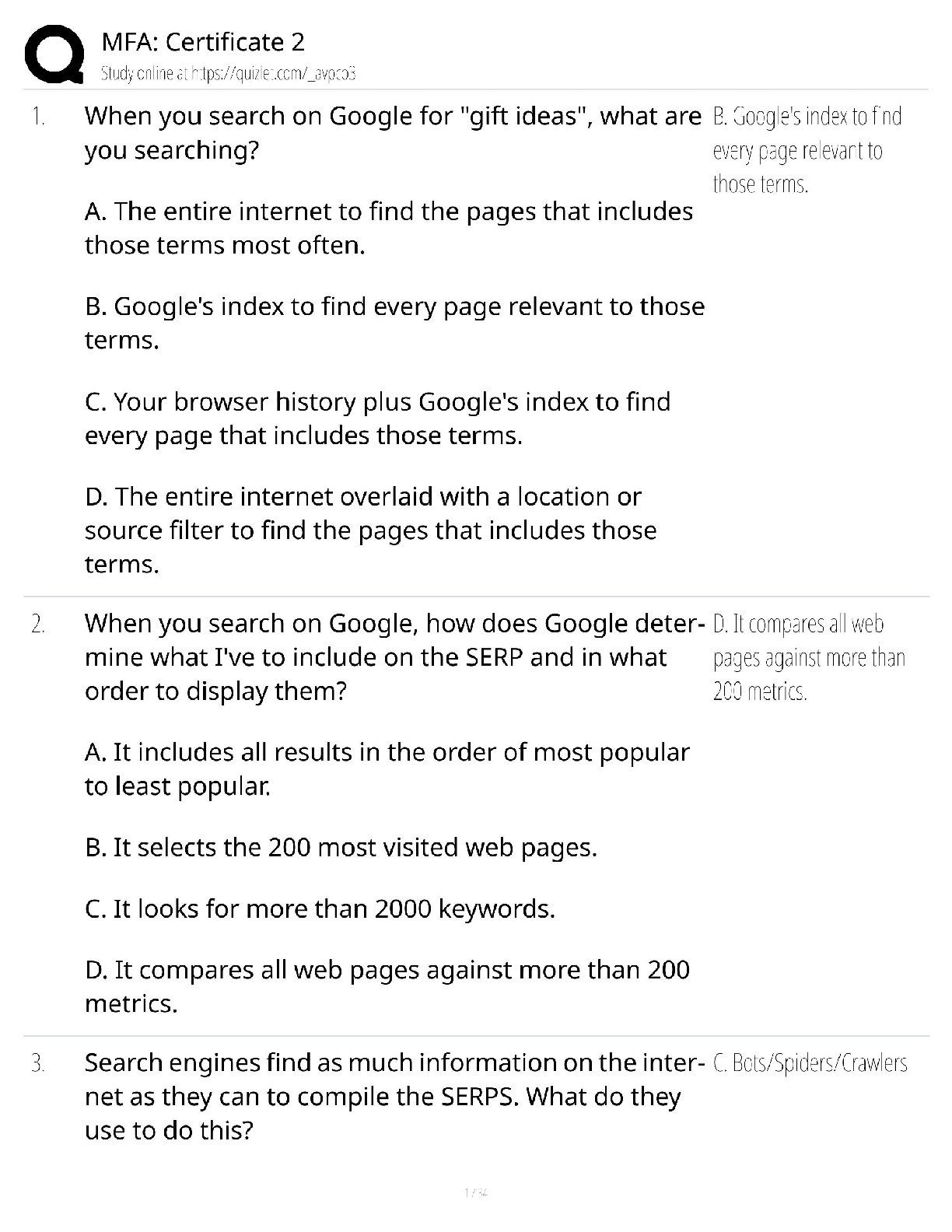*NURSING > QUESTIONS & ANSWERS > PCCM Exam 1 Questions and answers. Graded A+. 2022 (All)
PCCM Exam 1 Questions and answers. Graded A+. 2022
Document Content and Description Below
PCCM Exam 1 Questions and answers. Graded A+. 2022 What is the most important activity that caregivers should perform before and after contact with a patient to control infection? a. Documenta ... tion b. Hand hygiene c. Linen changing d. Gown changing - ✔✔b. Hand hygiene What is the recommended length of time for hand washing with ordinary soap and water? a. 0-10 seconds b. 10-15 seconds c. 15 or more - ✔✔c. 15 or more Microorganisms move from place to place by various means in a cyclical manner. What are the five elements in the cycle of infection? a. Reservoir, exit, transmission, infection, and susception b. Isolation, wound, contamination, infection, and sterilization c. Infection, contamination, decontamination, transmission, and exit d. Susception, reservoir, wound, isolation, and exit - ✔✔a. Reservoir, exit, transmission, infection, and susception In applying an alcohol-based hand rub, what is the appropriate step to take after rubbing the product briskly over all surfaces of the hands? a. Rinse the hands with water after every use. b. Continue to rub until the hands are dry. c. Rinse the hands with soap and water after every use. d. Use a paper towel to wipe residual hand rub from the hands. - ✔✔b. Continue to rub until the hands are dry. In which of the following scenarios is protective eyewear most important? a. Around a patient associated with airborne precautions b. In the transportation of a patient subject to contact precautions c. During times when blood splashes or sprays of other body fluids are likely d. When a patient is performing upper extremity exercises - ✔✔c. During times when blood splashes or sprays of other body fluids are likely For which of the following procedures might it be unnecessary to wear gloves? a. Controlling bleeding b. Performing oral or nasal suctioning c. Measuring blood pressure or temperature d. Handling or cleaning contaminated instruments - ✔✔c. Measuring blood pressure or temperature According to standard isolation precautions for airborne transmission, what is the recommended architecture for a patient's room? a. Cohort b. Private or cohort, preferably more than 3 feet between beds c. Private d. Private isolation room with a closed door - ✔✔d. Private isolation room with a closed door Which of the following objects is a potential host site for the survival of pathogens? a. Bar soap b. Sink rims c. Faucet handles d. All given answers are correct - ✔✔d. All given answers are correct What are the most common modes of transmission of pathogenic microorganisms? a. Gloves, masks, and gowns b. Tables, chairs, and beds c. Water and food d. Contact, droplet, airborne - ✔✔d. Contact, droplet, airborne During which of the following situations would the wearing of gloves be most appropriate? a. You are cleaning the therapy treatment area at the end of the day in your inpatient rehabilitation unit. b. You are opening packages of clean linens to place in the covered linen storage shelves. c. You are providing education for the patient and family. d. You have an open wound on your forearm where your kitten scratched you. - ✔✔a. You are cleaning the therapy treatment area at the end of the day in your inpatient rehabilitation unit. What factor does NOT affect the pulse oximeter (pulse ox) reading? a. Size of blood pressure cuff b. Raynaud's syndrome c. Artificial nails d. Poor circulation - ✔✔a. Size of blood pressure cuff What pain scale might you use with a 5 year old child? a. Faces b. Initial Pain Assessment Tool c. VAS (visual analog scale) d. McGill pain questionnaire - ✔✔a. Faces To determine how much to inflate the blood pressure cuff, find the occlusion point then inflate the cuff how many mm/Hg? Answers: a. 10 b. 15 c. 20 d. 30 - ✔✔c. 20 mm/Hg Which of the following vital sign readings is NOT within normal limits (WNL)? a. Temperature of 98 degrees b. Respiration of 23 bpm (breaths per minute) c. Heart rate of 90 bpm (beats per minute) d. Blood pressure 115/75 - ✔✔b. Respiration of 23 bpm (breaths per minute) The following is NOT a nonverbal indicator for pain? a. Grimacing b. Blinking c. Rubbing the affected area d. Restlessness - ✔✔b. Blinking Which pain scale involves the patient taking the average of 3 ratings over 24 hours? a. Faces b. NPRS c. VAS d. McGill - ✔✔b. NPRS Which of these patients may need to rest or be on supplemental oxygen- O2 sat= oxygen saturation? a. Pulse 90 bpm, O2 sat 95% b. Pulse 75 bpm, O2 sat 92% c. Pulse 80 bpm, O2 sat 88% d. Pulse 70 bpm, O2 sat 98% - ✔✔c. Pulse 80 bpm, O2 sat 88% Orthostatic hypotension (OH) is classified as a decrease in systolic blood pressure of greater than what? a. 10 b. 15 c. 30 d. 20 - ✔✔d. 20 mm Hg Which of these patients needs immediate medical attention? a. BP 160/90 b. Heartrate 98 c. Respiration 19 d. BP 180/100 - ✔✔d. BP 180/100 When fitting a blood pressure cuff, what percentage of the arm should the length of the bladder cover? a. 30% b. 40% c. 60% d. 80% - ✔✔c. 60% What area of the spine is host to most injuries caused by lifting? A. Cervical B. Thoracic C. Lumbar D. Sacrococcygeal - ✔✔C. Lumbar Which muscle group is most important for movements and lifts that require extra effort? A. Scapular stabilizers B. Ankle stabilizers C. Knee stabilizers D. Core stabilizers - ✔✔D. Core stabilizers All of the following are benefits of proper posture EXCEPT: A. It promotes effective and safe movements B. It promotes proper balance and postural control C. It increases stress on your joints D. It conserves energy - ✔✔C. It increases stress on your joints Which of the following would increase an individual's base of support (BOS)? A. Spreading the elbows out to the side when carrying a box in front of the body. B. Bending at the knees and hips C. Placing the feet farther apart in an anterior-posterior stance D. Placing the feet closer together - ✔✔C. Placing the feet farther apart in an anterior-posterior stance In an attempt to lift an object, which two measures are recommended for proper body mechanics? a. Increasing your base of support, positioning your COG near the object's COG b. Decreasing your base of support, positioning your COG near the object's COG c. Increasing your base of support, positioning your COG far from the object's COG d. Decreasing your base of support, positioning your COG far from the object's COG - ✔✔a. Increasing your base of support, positioning your COG near the object's COG Which of the following is true regarding the 'golfer's lift': A. The BOS is the feet in a lateral stance B. The weight bearing leg is fully extended C. The non-weight bearing leg is flexed D. It is used to pick up lighter objects - ✔✔D. It is used to pick up lighter objects At what level is the approximate center of gravity (COG) of a standing person? A. The navel B. The first lumbar segment C. The iliac crest D. The second sacral segment - ✔✔D. The second sacral segment Through which anatomical structure should a plumb line run during ideal postural alignment? a. Lateral malleolus b. Scapula c. Greater trochanter d. Bodies of the thoracic vertebrae - ✔✔c. Greater trochanter Which posture is recommended for performing activities below the waist, such as removing clothes from a front-loading dryer? A. Sitting, stooping, or kneeling B. Rotating at the spine while squatting C. Flexing forward at the hips with the knees extended D. Flexing at the hips while rotating at the spine - ✔✔A. Sitting, stooping, or kneeling The difference between a Deep Squat Lift and a Power Lift is: A. Power Lift requires you to keep your back straight while the Deep Squat Lift requires flexion of the spine B. A Deep Squat Lift requires a full squat and a Power Lift requires only a partial squat C. A Deep Squat Lift requires full knee flexion and partial hip flexion whereas a Power Lift requires full knee flexion and full hip flexion D. None of the above - ✔✔B. A Deep Squat Lift requires a full squat and a Power Lift requires only a partial squat Your patient is a 55-year-old man who just had a transtibial amputation secondary to a work-related accident. You are working with him on functional mobility just after his surgery. Which of the following represents the best positioning for this patient? a. Place a pillow under the knee of the residual limb to improve comfort in supine. b. Have him spend some time in prone each day to encourage extension of the affected hip and knee. c. Turn the affected leg out while he is sitting to stretch the hip adductor muscles. d. While he is sitting in the chair, position the knee in flexion to encourage circulation to the surgical site. - ✔✔b. Have him spend some time in prone each day to encourage extension of the affected hip and knee. What is a potential adverse effect of the placement of a small bolster behind the knees of a supine patient? a. Quadriceps and hip extensor contractures b. Erector spinae and ankle dorsiflexor contractures c. Iliopsoas and hamstring contractures d. Hip adductor and extensor contractures - ✔✔ Following a total hip replacement, what device is often used for proper positioning? a. An adduction pillow to prevent excessive hip adduction b. A continuous passive motion machine c. Lateral towel rolls to maintain hip adduction d. A full-length leg cast - ✔✔a. An adduction pillow to prevent excessive hip adduction Which areas of the side-lying patient are at greatest risk for pressure sores? a. Sternum, iliac crests, patellae, and lateral ears b. Lateral ears, lateral ribs, greater trochanters, and humeral epicondyles c. Occipital tuberosity, transverse processes of vertebrae, sacrum, and heels d. Forehead, spines of the scapulae, lesser trochanters, and fibular heads - ✔✔b. Lateral ears, lateral ribs, greater trochanters, and humeral epicondyles Your patient is a 64-year-old man who had a stroke and has severe right upper-extremity weakness as a result. His right hand has become very edematous. Which of the following is the best position for the patient's right arm to aid in the management of his edema? a. Across his chest while he is lying on his left side b. With the hand on a pillow, higher than the heart, while he is supine c. By his side with his fingers extended and his palm facing up while he is supine d. With the forearm supported on the armrest while he is sitting in a wheelchair - ✔✔b. With the hand on a pillow, higher than the heart, while he is supine Which of the following methods should you use to screen for patient tolerance of pressure on the skin? a. Press firmly with one or two fingers on the skin in question, hold for 30 seconds, then release. b. Press firmly with one or two fingers on the skin in question, hold for 1 minute, then release. c. Press gently with one or two fingers on the skin in question and quickly release. d. Press gently and quickly with one or two fingers on the skin in question three or four times, then release. - ✔✔c. Press gently with one or two fingers on the skin in question and quickly release. Your patient is a 49-year-old man who sustained a spinal cord injury in a skiing accident. He is unable to move below the level of his umbilicus. You are positioning him in the bed following your treatment. Which of the following describes the most appropriate positioning for this patient? a. On his back with a medium-sized pillow under his knees b. On his back with a large pillow behind his shoulder blades c. In a three-quarters supine position with pillows behind him and between his legs d. On his stomach with a large pillow under his feet - ✔✔c. In a three-quarters supine position with pillows behind him and between his legs Following a total knee replacement, in what position is it important to keep the affected extremity at rest? a. Knee flexion b. Knee extension c. Hip flexion d. Hip extension - ✔✔b. Knee extension In general, how frequently should a dependent patient's positioned be changed? a. At least every 2 hours b. At least every 4 hours c. Twice per day - ✔✔a. At least every 2 hours Which areas are especially prone to pressure sores in a patient who is wheelchair dependent? a. The mandible and knees b. Acromions and dorsal surfaces of the feet c. Ischial tuberosities and olecranon processes d. Tibial tubercles and the occiput - ✔✔c. Ischial tuberosities and olecranon processes During an upward movement transfer of a supine patient, how should the patient's lower extremities be positioned? a. With the hips and knees flexed and feet flat on the bed b. Fully extended on the bed c. Crossed with one ankle on top of the other d. With both hips fully adducted - ✔✔a. With the hips and knees flexed and feet flat on the bed When rolling a pt. from supine to prone, towards the patient's left side, the left UE should be positioned: a. across the body with the hand at the right shoulder b. in the reverse T position c. overhead in full shoulder flexion, if the patient has the range d. next to the trunk with the shoulder internally rotated and the palm down, tucked under the hip - ✔✔c. overhead in full shoulder flexion, if the patient has the range In general, how frequently should the patient's position be changed when immobile in bed? a. At least every 4 hours b. Once per day c. Twice per day d. At least every 2 hours - ✔✔d. At least every 2 hours When assisting a patient using only verbal cues to perform an activity safely and within an acceptable time frame, what level of assistance has been provided? a. Standby assistance b. Contact guarding c. Minimal assistance d. Independent - ✔✔a. Standby assistance When coordinating a lifting activity with others, how should directions be given? a. In the form of elaborate and detailed explanation b. As quickly and loudly as possible c. Mostly with the use of hand gestures d. As brief, concise, and action-oriented commands - ✔✔d. As brief, concise, and action-oriented commands When rolling a pt. from prone to supine, towards the patient's left side, how should the right lower extremity be positioned? a. the knee should be flexed to 90 degrees b. abducted and externally rotated c. crossed over the left leg at the ankles d. parallel to the left leg with the ankle dorsiflexed to neutral - ✔✔c. crossed over the left leg at the ankles When a patient is able to do 25% to 49% of a transfer they are considered to require: a. Maximum assistance b. Moderate assistance c. Minimal assistance d. Dependent - ✔✔a. Maximum assistance The most important action when assisting a patient to move around in bed is a. Apply pressure under the patient's axillae when rolling over b. Let the patient help as much as possible when permitted c. always keep the patient's feet next to each other in an extended position d. Lower the bed to below waist height for optimal body mechanics - ✔✔b. Let the patient help as much as possible when permitted What level of assistance is used if a patient requires only verbal cues to perform an activity safely and within an acceptable time frame? Answers: a. Moderate assistance b. Standby assistance c. Minimal assistance d. Contact guarding - ✔✔b. Standby assistance When performing a dependent transfer with a patient from supine to prone, how should the arm over which the patient will roll be positioned? a. adducted, externally rotated, elbow straight, and hand tucked under the pelvis, palm up b. abducted shoulder, flexed elbow and tuck the hand under the pelvis c. abducted with internal rotation, elbow flexed to 90 d. adducted and internally rotated with the hand over the pelvis, palm down - ✔✔a. adducted, externally rotated, elbow straight, and hand tucked under the pelvis, palm up Which body part is often wrapped in a circular pattern with a "figure of eights"? a. The forefoot and ankle b. The thigh c. The shoulder d. The head - ✔✔a. The forefoot and ankle In which position should a person in shock be placed? a. Supine with the head slightly lower than the lower extremities b. Sitting with the upper body supported c. Prone d. Side lying with the legs flexed toward the chest - ✔✔a. Supine with the head slightly lower than the lower extremities Which of the following are considered severe reactions to an allergy? a. Itchy skin and sneezing b. Itchy and watery eyes c. Hives and skin redness d. Abdominal pain and difficulty swallowing - ✔✔d. Abdominal pain and difficulty swallowing Over which body part should [Show More]
Last updated: 3 years ago
Preview 1 out of 22 pages
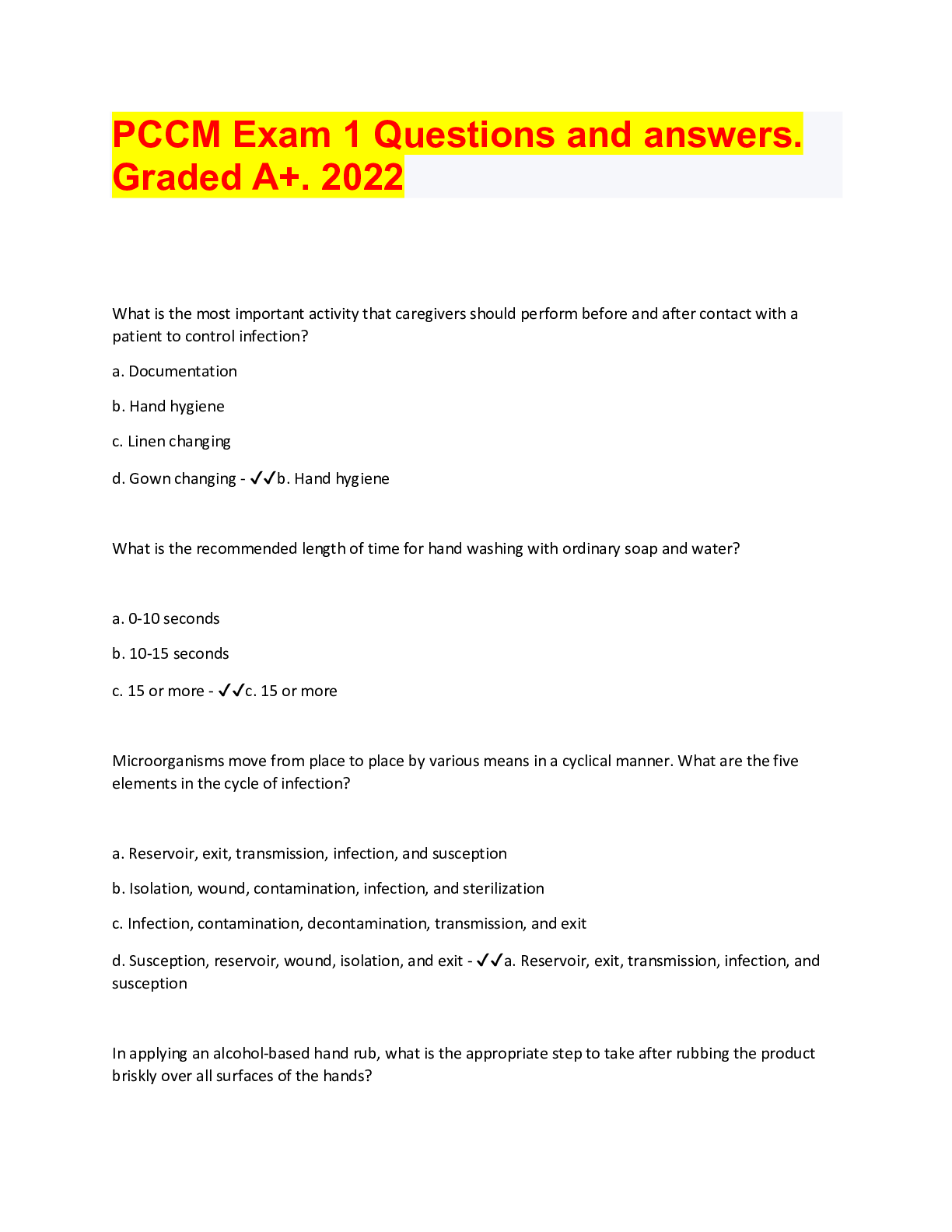
Buy this document to get the full access instantly
Instant Download Access after purchase
Buy NowInstant download
We Accept:

Also available in bundle (1)
Click Below to Access Bundle(s)
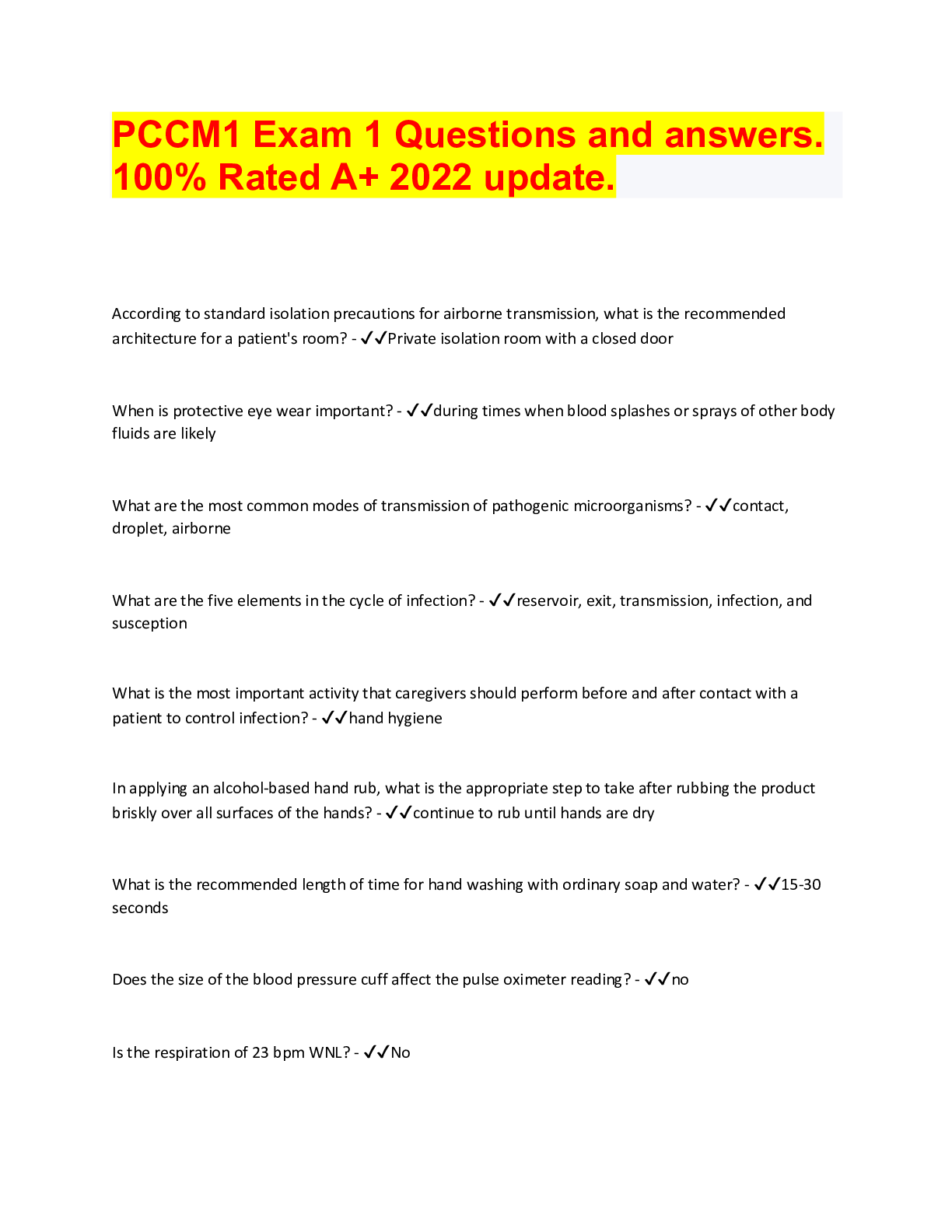
The PCCM Bundle, Exam Questions and answers
All you need to pass the PCCM exams, Latest updates, Graded A+
By bundleHub Solution guider 3 years ago
$30
9
Reviews( 0 )
$10.00
Can't find what you want? Try our AI powered Search
Document information
Connected school, study & course
About the document
Uploaded On
Aug 22, 2022
Number of pages
22
Written in
All
Seller

Reviews Received
Additional information
This document has been written for:
Uploaded
Aug 22, 2022
Downloads
0
Views
155













